
Photo by: Duane Daws
In recognition of its environmental sustainability, the new head office of construction major Group Five, located at the Waterfall Estate, in Midrand, has achieved both a Design and As Built 5-Star Green Star South Africa (SA) rating from the Green Building Council of South Africa (GBCSA), bringing the number of GBCSA accolades it has achieved to four.
The 24 000 m2 building, which was designed by WSP Parsons Brinckerhoff and developed by capital growth fund Attacq, had previously been awarded a 5-Star Green Star SA Design certification in 2013 under the GBCSA’s Office v1 Rating Tool, as well as an As Built certification following its completion in February.
Elaborating on the development’s green features, WSP noted in a statement that the building had been designed to achieve a 150% improvement in required fresh air rates, while carbon dioxide (CO2) sensors provided constant air-quality readings to the building management system, which would automatically adjust fresh air rates should CO2 levels rise.
Internal air quality was further preserved through the use of organic compounds paints, carpets and sealants, while dedicated tenant exhaust risers extract printer fumes at the source, reducing the build-up of harmful indoor pollutants.
Additionally, the building had been designed to combat daylight glare, with 80% of the office’s usable areas offering access to an outside view.
Further energy savings were realised through the installation of occupancy sensors, while
energy meters were extensively used to monitor energy use and identify unusual or excessive consumption.
“This is an important mechanism to manage the building and optimise operating schedules. Group Five also took the decision to install ammonia chillers, which operate at higher levels of efficiency to conventional chillers.
“Additionally, a thermal storage system has been provided to reduce peak energy demand on the national power grid,” WSP Parsons Brinckerhoff building services Africa sustainability consultant Alison Groves outlined.
In terms of water, low flow rate fixtures and fittings were installed throughout the building to restrict flow, while further water savings were achieved by capturing rainwater for reuse in irrigation and sanitation.
Water meters had also been installed throughout the building to continually monitor all major water use areas and aid in early detection of water leaks.
“The project elected to use air cooled heat rejection for the ammonia chillers, removing a huge water burden from the operation of the building and ensuring air conditioning resilience in a potentially water stressed future,” she added.
According to Groves, WSP Parsons Brinckerhoff also worked closely with the project team to ensure that the materials used on site were in line with sustainability requirements and that, overall, the greenhouse-gas emissions associated with the operational phase of the building were reduced.
“The team worked closely with Group Five in the 12-month handover period, which included monthly monitoring, quarterly reporting and a full recommissioning at the end of the project,” she noted.